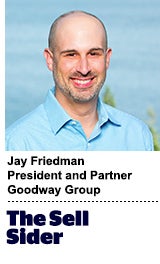“The Sell Sider” is a column written for the sell side of the digital media community.
Today’s column is written by Jay Friedman, president and partner at Goodway Group.
Change only occurs when there is sufficient dissatisfaction with the status quo. For the last 20 years, the number of events that have dissatisfied publishers has been building, yet the degree to which publishers have changed their business model – from this buyer’s perspective at least – always seemed to be short of what’s needed to thrive.
Some 20 years ago publishers devalued their inventory by selling to ad networks. This only confirmed that direct prices were inflated to begin with. Then came fraud, partially self-inflicted and enabled through traffic acquisition. Then came limited viewability, partially caused by site design. Then came Safari and Firefox users, which drove down those CPMs by 30-40%. Each step here required meaningful change. Instead, most publishers seemed to change just enough at each turn to avoid disaster.
With the deprecation of third-party cookies in Chrome, this time will be different. Publishers will need to change significantly to avoid seeing their entire inventory priced 30-40% lower.
With this two-year warning from Google, smart publishers aren’t facing a crisis but a massive opportunity: A significant change of some sort is required just to survive, and so publishers can now make the case for wholesale changes that solve for 20 years of Band-Aids.
Start at the beginning
“The voice of the customer” has been a topic garnering more and more attention in recent years. Buyers are also one of publishers’ customers. Buyers and publishers aren’t adversaries, but business partners that each deliver on the other’s needs. While each buyer is different, here is a generalized look at a buyers’ hierarchy of needs from publishers.
The order here is vital. Even just three or four years ago, level one – human users and correct domain – couldn’t be guaranteed. Today, publishers that implement ads.txt, app-ads.txt and sellers.json are well on their way to meeting a buyer’s most fundamental need.
We’ll assume publishers reading this are operating sites that meet most buyers’ brand safety needs, so we’ll move past level two.
At level three we find the Band-Aids overstretched. It’s amazing how many publishers still don’t have sites with strong viewability, despite it being a requirement for most major advertisers.
The Chrome announcement gives publishers two years to fundamentally rethink how content will be monetized. Having made such great progress in fraud minimization and viewability measurement, publishers would be wise to accept the current state of fraud and viewability as stable and solve for them. Floating (or fixed) ads should be a staple ad unit on every site to create nearly 100% viewability. Those ads can be even better monetized than they are today and move us to level four.
Audience: This is make or break
Publishers have largely lost the audience game. While Google and Facebook have amassed the largest audience graphs in the history of media, publishers have helped Google and Facebook harness that data by participating in Google Display Network and Facebook Audience Network. As the third-party cookie crumbles and programmatic buyers are left wanting for better audience data, publishers face what I believe is the most significant and pivotal moment of the 2020s.
Here I’m reminded of something an old boss said to me: “You can either be right or successful, but almost never both.” Publishers, you may be right. You may have a great audience, original content and a clean site with highly viewable ads. But being right won’t make you successful. Being successful requires that you compete against Facebook and Google.
This has historically happened by enabling both the sale of third-party data and its purchase against a publisher’s own visitors. Going forward will require continuing to enable cross-site intelligence, but in a different way, because 30-40% lower CPMs aren’t viable for publishers, and unknown audiences in display and online video are such a step backward that money will otherwise move to other channels.
I believe publishers must find a way to share data with each other in a privacy-compliant, programmatically-enabled way. This is a requirement for a healthy open web and a healthy longtail. This is a requirement for journalism to continue in its current form, meaning there is much more at stake than whether or not some ads are targeted intelligently. Only after enough publishers come together or participate in a shared solution (think authenticated traffic or similar) will we ensure the survival of this ecosystem.
Once this is solved – and it won’t be easy – the roller coaster will have peaked and we’ll be on the downhill. With a healthy open web tied to known audiences, quality content can flourish. CPMs will be at a healthy level that delivers value to advertisers and profit to publishers. From there, I – even as a buyer – strongly encourage publishers to refresh their floating ads after 10 seconds of confirmed viewability. This is significantly longer than most ads are viewed today, giving an improved customer experience for advertisers. It also enables publishers to make more money when they produce quality content by refreshing the ad more often.
I’ve always thought the word “existential” was overused – until now. Publishers’ existence has been threatened for 20 years, but that threat has now reached a critical level. Publishers must find a way to enable cross-site intelligence, even among competing publishers, to keep CPMs healthy and enable the best open web possible. Even if the industry devises a browser or device ID solution, publishers are significantly better off making these fundamental changes. In fact, Facebook and Google benefit from this too, creating a healthier ecosystem overall.
Follow Jay Friedman (@jaymfriedman) and AdExchanger (@adexchanger) on Twitter.















